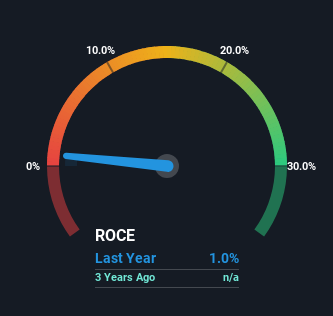- South Korea
- /
- Electrical
- /
- KOSE:A361610
SK IE Technology's (KRX:361610) Returns On Capital Not Reflecting Well On The Business

Finding a business that has the potential to grow substantially is not easy, but it is possible if we look at a few key financial metrics. In a perfect world, we'd like to see a company investing more capital into its business and ideally the returns earned from that capital are also increasing. This shows us that it's a compounding machine, able to continually reinvest its earnings back into the business and generate higher returns. In light of that, when we looked at SK IE Technology (KRX:361610) and its ROCE trend, we weren't exactly thrilled.
What Is Return On Capital Employed (ROCE)?
For those who don't know, ROCE is a measure of a company's yearly pre-tax profit (its return), relative to the capital employed in the business. Analysts use this formula to calculate it for SK IE Technology:
Return on Capital Employed = Earnings Before Interest and Tax (EBIT) ÷ (Total Assets - Current Liabilities)
0.0095 = ₩32b ÷ (₩4.1t - ₩718b) (Based on the trailing twelve months to December 2023).
So, SK IE Technology has an ROCE of 1.0%. Ultimately, that's a low return and it under-performs the Electrical industry average of 8.3%.
Check out our latest analysis for SK IE Technology

In the above chart we have measured SK IE Technology's prior ROCE against its prior performance, but the future is arguably more important. If you'd like to see what analysts are forecasting going forward, you should check out our free analyst report for SK IE Technology .
The Trend Of ROCE
On the surface, the trend of ROCE at SK IE Technology doesn't inspire confidence. Around two years ago the returns on capital were 3.3%, but since then they've fallen to 1.0%. Although, given both revenue and the amount of assets employed in the business have increased, it could suggest the company is investing in growth, and the extra capital has led to a short-term reduction in ROCE. And if the increased capital generates additional returns, the business, and thus shareholders, will benefit in the long run.
The Key Takeaway
Even though returns on capital have fallen in the short term, we find it promising that revenue and capital employed have both increased for SK IE Technology. These growth trends haven't led to growth returns though, since the stock has fallen 26% over the last year. So we think it'd be worthwhile to look further into this stock given the trends look encouraging.
While SK IE Technology doesn't shine too bright in this respect, it's still worth seeing if the company is trading at attractive prices. You can find that out with our FREE intrinsic value estimation for A361610 on our platform.
While SK IE Technology may not currently earn the highest returns, we've compiled a list of companies that currently earn more than 25% return on equity. Check out this free list here.
New: Manage All Your Stock Portfolios in One Place
We've created the ultimate portfolio companion for stock investors, and it's free.
• Connect an unlimited number of Portfolios and see your total in one currency
• Be alerted to new Warning Signs or Risks via email or mobile
• Track the Fair Value of your stocks
Have feedback on this article? Concerned about the content? Get in touch with us directly. Alternatively, email editorial-team (at) simplywallst.com.
This article by Simply Wall St is general in nature. We provide commentary based on historical data and analyst forecasts only using an unbiased methodology and our articles are not intended to be financial advice. It does not constitute a recommendation to buy or sell any stock, and does not take account of your objectives, or your financial situation. We aim to bring you long-term focused analysis driven by fundamental data. Note that our analysis may not factor in the latest price-sensitive company announcements or qualitative material. Simply Wall St has no position in any stocks mentioned.
About KOSE:A361610
SK IE Technology
Engages in manufacturing and selling of battery materials in South Korea, Asia, and Europe.
High growth potential minimal.
Market Insights
Community Narratives



